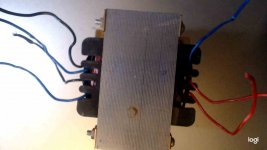I think it's about time i learn how to identify transformer leads. I was doing my homework today. It was beginning to make sense until i looked at this thing.
It was a step/ step down/ 1:1 transformer. the 2 black and 2 blue , i believe were the primaries used and combinations for 110 or 220. The two small red leads went to an indicator circuit. That leave one lead for secondary. I know there is none missing. How do i test,and then use it as an isolation transformer?
It was a step/ step down/ 1:1 transformer. the 2 black and 2 blue , i believe were the primaries used and combinations for 110 or 220. The two small red leads went to an indicator circuit. That leave one lead for secondary. I know there is none missing. How do i test,and then use it as an isolation transformer?
Attachments
Last edited:
> leave one lead for secondary.
Electrons always run in LOOPS.
One lead is not a loop.
A winding can have more than one lead. "Center tap" is super popular.
Use your meter, or buzzer, to find out what connects to what. Getting the Ohms of each winding is a slight clue to relative voltages.
Electrons always run in LOOPS.
One lead is not a loop.
A winding can have more than one lead. "Center tap" is super popular.
Use your meter, or buzzer, to find out what connects to what. Getting the Ohms of each winding is a slight clue to relative voltages.
Are you sure that is a mains transformer ?
If the blue and black were the primaries then the blues would be connected together and the blacks together for 110V.
If you want to use it at 240V then one blue and black are connected together and insulated and the 240V connected across the other black and blue.
Can you measure the resistances between the secondary wires.
If the blue and black were the primaries then the blues would be connected together and the blacks together for 110V.
If you want to use it at 240V then one blue and black are connected together and insulated and the 240V connected across the other black and blue.
Can you measure the resistances between the secondary wires.
Last edited:
It is most likely a centre tapped transformer.
Dual voltage transformers usually use different coloured wires to denote the different outputs.
Dual voltage transformers usually use different coloured wires to denote the different outputs.
The 2 blacks have continuity and resistance. Then on the other side there is just that 1 blue wire. i dont get it. But then again, I guess either pair could be consider primary. It would just depend on whether you were stepping up or down. Does that make sense? The orpnan blue wire would be the center tap the higher side?
It would be VERY POOR transformer practice to have primary and secondary wires crossed over - Damn Right Dangerous comes to mind.
bk1-bu1= 4.4 ohms
bk1-bk2=6.2 ohms
bk1-bl2=10.2 ohms
bl1-bk2=2.5 ohms
bl1-bl2=6.5 ohms
bk2-bl2=4.5 ohms
bk1-bl3=15.7 ohms
b11-bl3=16 ohms
bk2-bl3=10.6 ohms
bl2-bl3=9.5 ohms
bk1-bk2=6.2 ohms
bk1-bl2=10.2 ohms
bl1-bk2=2.5 ohms
bl1-bl2=6.5 ohms
bk2-bl2=4.5 ohms
bk1-bl3=15.7 ohms
b11-bl3=16 ohms
bk2-bl3=10.6 ohms
bl2-bl3=9.5 ohms
- Home
- Amplifiers
- Power Supplies
- Transformer Polarity.
